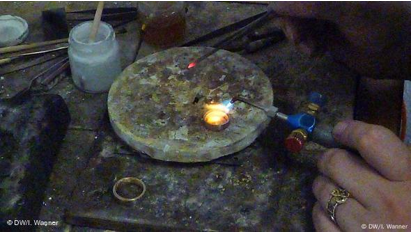آئی این پی ویلتھ پی کے
Muhammad Luqman
Business in most of the gold markets in Lahore starts at around 12:00 noon, but Khizar Hayat, along with his sons, comes to the Dhobi Mandi gold market at around 9:00 am to sweep the dusty ramps of the jewelry shops and collect garbage, reports WealthPK.

He doesn’t look for solid waste like plastics or ordinary metals. Actually, he is a gold miner – a Neyarya. For the last 30 years, Khizar and his family have been sifting and filtering the trash to collect gold flakes. This activity is not limited to the Dhobi Mandi area of Anarkali alone, as hundreds of workers like Khizar visit gold markets like Suha Bazaar, Town Ship market and Gold Mine Plaza on Ferozepur Road to try their luck.
But with the decreased demand for gold jewelry after the skyrocketing increase in the yellow metal prices, the Neyarya business is becoming less lucrative. For this reason, a number of gold miners have switched to other jobs. “People ask us why we work so hard just to get a handful of gold glints. I say this is the only job we know to earn money from,” Khizar told WealthPK.
This is his third generation engaged in the field of Neyarya. A number of his relatives have left this profession due to the decrease in the available gold dust in the garbage. In addition to collecting trash from the shops’ ramps, Neyaryas also buy trash from jewelry workshops containing a considerable percentage of gold dust (Neyara) and other metals like silver, copper and brass.
“Trash is usually sold by these workshops after months. The amount we pay to the jewelers ranges from thousands to lakhs,” said Khizar. In addition to trash collection, a number of Neyaryas also filter the municipal waste water from the manholes of gold markets to get gold flakes. The sludge filtered out from the waste water sometimes contains gold dust. “It is very rare to get gold from the gutter water.
Yet I try my luck and sometimes gold flakes are found,” Sajan Masih said. Trash collection is the first part of the process. The bags of trash are sent to make-shift laboratories, mostly set up on the top floors of gold markets. The next step involves manual filtration of the trash into small pools of water. The useful sludge is collected at top of the pool, while the rest is discarded.
The metals thus separated are treated with sulfuric acid and nitric acids. “Most of the times these Neyaryas get one ratti (0.12 gram) or two rattis (0.24 gram) of gold from a big sack of trash. Other metals, recovered during the process, are silver, nickel, copper and brass,” Moazzam Waheed, Vice Chairman of the Gems and Jewelers Association, Dhobi Mandi, told WealthPK.
He said the only metal that does not dissolve in nitric acid is gold. So, Neyaryas treat the metals found from the trash with nitric acid at the end of the entire process and sell gold to local jewelers. “Despite the increase in gold prices, a Neyarya family earns just a couple of thousands of rupees at the end of hours-long struggle,” Moazzam said.
Moreover, gold casting workshops are now switching over to such a technology that has minimized gold wastage during the casting process. “Moreover, with the increase in the demand for artificial jewelry and import of gold jewelry, the Neyarya profession is declining,” Chaudhary Rehmat, a jeweler in Township gold market, told WealthPK. He feared that the Neyarya profession might become a thing of the past in next five years.
Credit: INP-WealthPk



